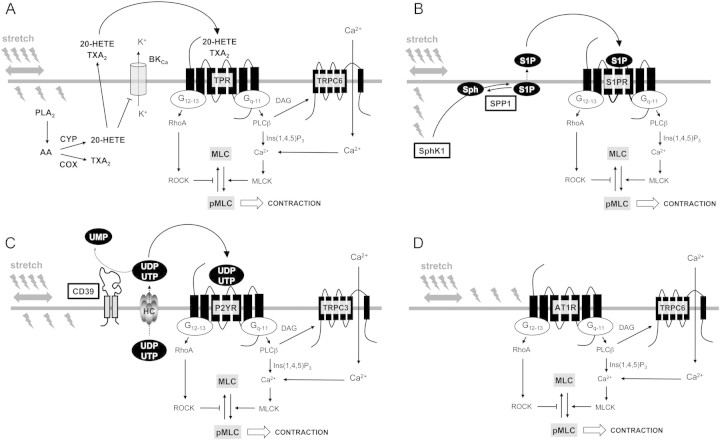Figure 2.
Proposed mechanism of local GPCR agonists in response to smooth muscle stretch. VSMC stretch activates the generation and release of several autacoids. (A) Phospholipase A2 generates arachidonic acid (AA), which can be metabolized into thromboxane A2 (TXA2) and 20-hydroxyeicosatetraenoic acid (20-HETE) through the respective action of cyclooxygenase (COX) and cytochrome P450 (CYP) enzymes. 20-HETE inhibits calcium-activated potassium channels (BKCa), thus limiting VSMC hyperpolarization. Both TXA2 and 20-HETE may act locally on an autocrine mode on VSMC TP receptor (TPR). (B) Sphingosine kinase-1 (SphK1) translocates to plasma membrane in response to stretch and phosphorylates sphingosine (Sph) to generate sphingosine-1-phosphate (S1P). This reaction is functionally antagonized by the sphingosine-1-phosphate specific phosphatase (SPP1). S1P activates S1P2 or 3 receptors (S1PR) to reinforce contraction. (C) Nucleotides are released in response to cell stretch,72 most probably through membrane hemichannels (HC). Autocrine activation of purinergic receptor (P2YR) by uridine-5′-tri and/or diphosphate (UTP, UDP) reinforces contraction. UTP receptor-dependent activation of TRPC3 channel further increases Ca2+ rise. This effect of extracellular nucleotides is controlled by CD39 ectonucleotidase.70 (D) AngiotensinII type 1 receptor (AT1R) has been proposed to be directly activated by stretch and to subsequently activate TRPC6 channels.78

